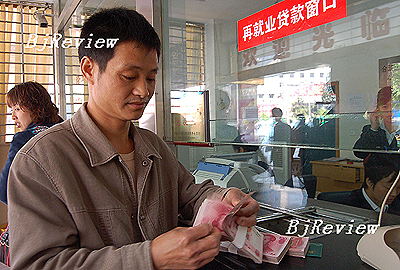|

China's tight monetary policy, adopted late last year, faces serious challenges at the beginning of 2008. According to the People's Bank of China, the central bank, January witnessed record-high credit growth with a total of 803.6 billion yuan ($112.1 billion) of new loans. The broad money supply, or M2, jumped 18.94 percent in January year on year, the biggest surge since May 2006. Both the growth in bank loans and the M2 have outpaced market expectations.
Of the newly added loans, medium- and long-term loans achieved record highs, both for households and enterprises. Lin Zhaohui, an analyst with Guotai Jun'an Securities Co. Ltd., said these were signs that loan expansion had picked up momentum.
At the end of last year, the Chinese Government pledged to cap credit increases in 2008 under 3.6 trillion yuan ($502.1 billion). However, the first month has gobbled up 22.3 percent of the target, further increasing pressure on its tight monetary policies for the rest of the year.
The central bank pointed out that the continuous acceleration of credit growth will further undermine the stability of the macro-economy and the healthy operation of financial institutions.
Quarterly controls
The central bank has given its explanation for the robust credit growth: Tight credit control policies beginning in the fourth quarter last year have contributed to a pile up of contracted loans, most of which were released in January.
Central bank statistics show that the combined lending growth of last November and December had dropped by 271.8 billion yuan ($37.9 billion) over the previous year. As a result, a lot of commercial banks delayed their new loans until the beginning of this year, resulting in a firm rebound in credit growth in January.
For some, this is not a convincing reason for the surge in credit growth. Gao Huiqing, Director of the Development Strategy Division with the Economic Prediction Department under the State Information Center, holds a different opinion. What really matters is that the central bank has imposed quarterly credit quotas on lenders instead of on the usual yearly basis, Gao said.
In the past, banks distributed more loans in the first quarter because longer loan maturities would generate more profits. Regarding the current quarterly controls, lending in the first month of the quarter is apparently their preference. Another factor is that bank creditors can relieve pressure on themselves by fulfilling their credit targets at an earlier date.
Gao also noted that the credit escalation in January was partly affected by the Spring Festival and the disastrous winter weather across southern, eastern and central parts of China. Since the Spring Festival fell in February this year, enterprises were compelled to procure loans in January, and some borrowed ahead to ensure cash supplies for February and March. At the same time, the central bank made calls for relief of areas hit hard by winter snowstorms. The central bank and the "Big Four" state-owned commercial banks have lent nearly 10 billion yuan ($1.4 billion) as part of these efforts.
Withdrawal symptoms
The phenomenal January credit statistics have added even more motivation for China to tighten its monetary stance. On February 14, the central bank made this year's first move of open-market operation, coinciding with the release of January financial data. It issued 195 billion yuan ($27.2 billion) of central bank bills of different maturities, striking near a one-year record high.
Among the newly issued central bank bills, compared to the previous issuance, three-year and one-year bills soared from 23 billion yuan ($3.2 billion) and 60 billion yuan ($8.4 billion) to 90 billion yuan ($12.6 billion) and 75 billion yuan ($10.5 billion), respectively. Only three-month bills registered a decline, down from 45 billion yuan ($6.3 billion) to 30 billion yuan ($4.2 billion).
This move can be read as a tone setter for credit control in the first half of 2008. It is expected that tighter control over credit amounts will be adopted in the short and medium term. Amid uncertainties of new interest rate hikes, this will serve as a major policy measure for the long term.
According to Yin Zhongli, a researcher with the Institute of Finance and Banking, Chinese Academy of Social Sciences, the central bank will rely more on administrative and window guidance, aside from issuing central bank bills. "Window guidance may be more conducive with an instant effect," said Yin.
As a mild and non-enforceable tool of monetary policy, window guidance refers to advice given by the central bank regarding the credit conduct of commercial banks. In the first half of 2004, the central bank and the China Banking Regulatory Commission put a tight grip on credit expansion through window guidance to commercial banks. At that time, the advice effectively helped curb credit explosion and optimize the credit structure.
Instituting countermeasures
The central bank has obviously felt pressure from the lending fever. On February 10, four days ahead of the release of January's statistics, its Shanghai headquarters raised five requirements for Shanghai commercial banks that also apply to their counterparts across the country.
| 